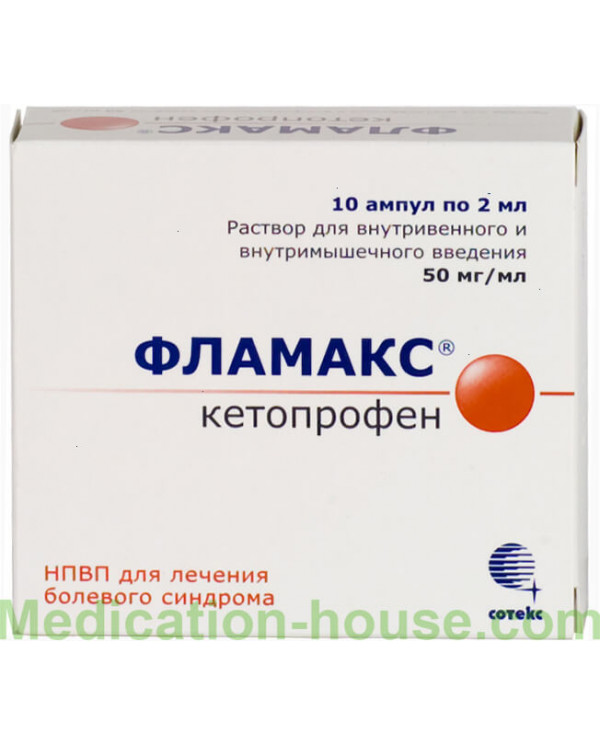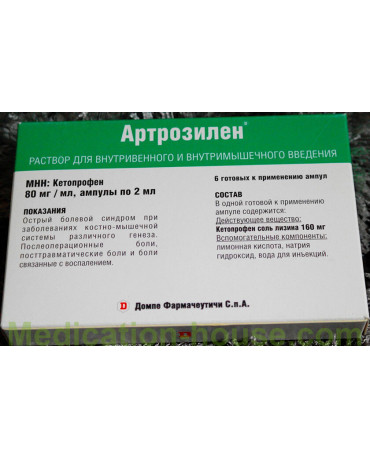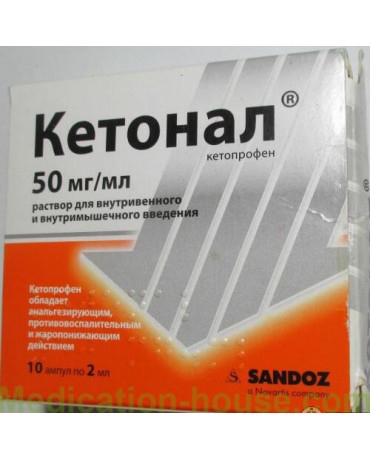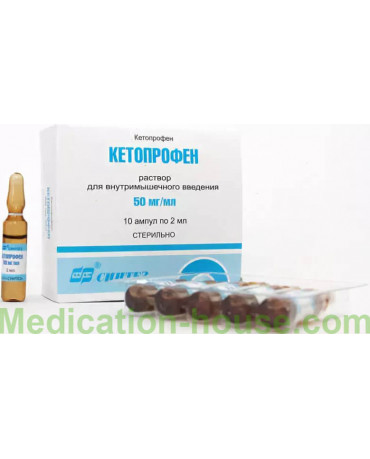Instruction for Flamax
You can buy injections Flamax on this page
Suppresses the activity of the enzyme cyclooxygenase type 1 and type 2, which regulates the synthesis of prostaglandin pain and inflammation mediators. The analgesic effect of the drug is due to the central and peripheral mechanism.
It is used for symptomatic treatment of pain and inflammatory processes of various origins. The pharmaceutical composition is produced by pharmacological companies in the form of capsules and a solution intended for intravenous and intramuscular administration.
Composition and release form
solution for intramuscular and intravenous administration: a clear liquid that does not have a color or with a slight yellowish tinge (2 ml in dark glass ampoules, 5 ampoules in a blister, 1 or 2 blister packs in a carton pack).
The composition of 1 ml of solution:
active ingredient: ketoprofen - 50 mg;
auxiliary components: ethanol, sodium hydroxide (until reaching a pH of 6.5–7.5), benzyl alcohol, propylene glycol, water for injection.
Pharmacological effect
The drug Flamax is a powerful anti-inflammatory drug of non-steroid nature.
Ketoprofen is a derivative of propionic acid, anti-inflammatory, antiplatelet, analgesic and antipyretic effect. The basis of the mechanism of the therapeutic action of ketoprofen is the effect on the cyclooxygenase and lipoxygenase link of the arachidonic acid exchange processes. Against the background of the activity of the drug, the synthesis of prostaglandins, leukotrienes and thromboxanes is reduced, which leads to a reduction in the symptoms of fever, the elimination of inflammatory processes and the suppression of platelet aggregation. Due to the peripheral and central effects of the drug has a pronounced analgesic effect.
Approximately 99% of ketoprofen can create bonds with plasma proteins. A stationary amount of a substance is established already 24 hours after oral or injection use. The tool is subjected to glucuronidation in the liver with the formation of metabolites in the form of esters. Almost completely excreted by the kidneys. With feces goes up to 1% of Flamax. The half-life can be from 1.5 to 2 hours.
Indications for use
Flamax is used for the symptomatic treatment of moderate pain syndrome and inflammations of various etiologies (the drug does not affect the progression of the disease):
radiculitis;
ossalgia;
myalgia;
arthralgia;
pain in cancer;
inflammatory diseases of the pelvic organs (including adnexitis);
postoperative pain;
degenerative and inflammatory diseases of the musculoskeletal system (ankylosing spondylitis, osteoarthritis of the spine and peripheral joints, juvenile chronic arthritis, rheumatoid arthritis, gouty arthritis, psoriatic arthritis, rheumatoid lesions of soft tissue);
neuralgia;
bursitis, tendonitis;
pain during menstruation;
toothache;
migraine, headache;
otitis pain;
sciatica, lumbago;
painful post-traumatic syndrome, accompanied by inflammation.
Contraindications for Flamax
The drug is contraindicated for use in the following situations:
ulcerative colitis;
hemophilia;
childhood;
bronchial asthma;
private body reactions that occur in response to taking NSAIDs or acetylsalicylic acid preparations;
recurrence of gastric ulcer;
duodenal ulcers;
kidney and liver failure;
violations in the blood system;
period of pregnancy and breastfeeding.
With the observance of the rules of increased caution, the composition may be appointed in the following conditions:
coronary heart disease;
blood pathology;
stomatitis;
arterial hypertension;
cirrhosis of the liver;
alcohol and long-term nicotine addiction;
liver and kidney failure;
sepsis;
dehydration;
diabetes;
puffiness;
childhood;
advanced age.
Prescribing Flamax in childhood is not recommended. Elderly patients require dose adjustment.
Appointment during pregnancy and lactation
Do not use Flamax for treating women in the third trimester of pregnancy, as well as during lactation. If necessary, treatment with the agent in the first and second trimesters is possible, but only if the expected benefit exceeds the risk level for the fetus.
Dosage and method of use
As indicated in the instructions for use Flamax is intended for intravenous and intramuscular injection.
V / m introduction: 100 mg (1 ampoule) 1-2 times / day.
In / in the infusion of Flamax should be carried out only in a hospital. The average infusion time is 0.5-1 h, the maximum is no more than 48 h, and the dose of the drug should not exceed 300 mg.
Short in / in infusion: 100-200 mg (1-2 ampoules) of the drug, diluted in 100 ml of 0.9% sodium chloride solution, injected within 0.5-1 hours. Repeated administration after 8 hours is possible.
Prolonged intravenous infusion: 100–200 mg (1–2 ampoules) of the drug diluted in 500 ml of solution for infusions (0.9% sodium chloride solution, Ringer’s solution, 5% dextrose solution) within 8 hours. Repeated administration is possible through 8 h
The minimum effective dose should be used with the shortest possible short course.
Adverse reactions
During treatment with Flamax in patients with hypersensitivity to ketoprofen or acetylsalicylic acid, the following side effects may develop:
nervous system: peripheral neuropathy, nervousness, headache, insomnia, dizziness, agitation, drowsiness, depression, memory impairment, asthenia, loss or confusion, migraine;
digestive system: abdominal pain, dyspepsia (in the form of decreased appetite, nausea, vomiting, heartburn, flatulence, diarrhea), stomatitis, taste change, impaired hepatic function; with prolonged use of large doses - ulceration of the mucous membrane of the gastrointestinal tract; gastrointestinal, gingival, hemorrhoidal bleeding;
urinary system: hematuria, cystitis, edematous syndrome, urethritis, renal dysfunction, nephrotic syndrome, interstitial nephritis;
sensory organs: ringing / tinnitus, conjunctivitis, blurred vision, dry eye mucosa, conjunctival hyperemia, eye pain, hearing loss, vertigo;
hematopoietic system: anemia, thrombocytopenia, agranulocytosis, hemolytic anemia, leukopenia;
cardiovascular system: tachycardia, increased blood pressure;
allergic reactions: skin rash (including erythematous rash, urticaria), rhinitis, pruritus, anaphylactic shock, angioedema, exfoliative dermatitis, bronchospasm;
others: photosensitization, increased sweating, nasal bleeding, hemoptysis, myalgia, muscle twitching, thirst, shortness of breath; when conducting a long course in large doses - vaginal bleeding.
Overdose
Cases of overdose of Flamax are not described. The main possible symptoms of this condition can be: shortness of breath, vomiting, dizziness, headache, bleeding, abdominal pain, impaired renal and / or hepatic function.
Treatment for symptomatic overdose, data on the specific antidote of ketoprofen is not available.
special instructions
Before you start using Flamax, read the specific instructions:
During treatment, control of the pattern of peripheral blood and the functional state of the liver and kidneys is necessary.
If necessary, determine the 17-ketosteroids drug should be canceled 48 hours before the study.
In violation of the functions of the liver and kidneys, a dose reduction and careful observation are necessary.
With simultaneous use of the drug Flamax and warfarin or lithium preparations, patients should be under the strict supervision of a physician.
Care must be taken when prescribing the drug to patients with gastrointestinal ulcers in history, renal or hepatic insufficiency, as well as receiving coumarin anticoagulants.
Like other drugs in this group, it can mask the symptoms of infectious diseases.
To reduce the risk of adverse events from the gastrointestinal tract, use the minimum effective dose of the shortest possible course.
Compatibility with other drugs
When using Flamax, you must consider the interaction with other drugs:
Simultaneous use with sodium valproate results in a reduction in platelet aggregation.
Ketoprofen increases plasma concentration of verapamil and nifedipine, lithium preparations, methotrexate.
Antacids and colestyramine reduce ketoprofen absorption.
Myelotoxic drugs increase the hematotoxicity of Flamax.
Simultaneous use with oral anticoagulants, heparin, thrombolytic agents, antiplatelet agents, cefoperazone, cefamundol and cefotetan increases the risk of bleeding.
Ketoprofen enhances the hypoglycemic effect of insulin and oral hypoglycemic drugs (dose recalculation is required).
The inducers of microsomal oxidation enzymes in the liver (phenytoin, ethanol, barbiturates, rifampicin, phenylbutazone, tricyclic antidepressants) increase the production of hydroxylated active metabolites.
Flamax can be combined with centrally acting analgesics; can be mixed with morphine in one bottle. Do not mix in one bottle with tramadol due to precipitation.
Parenteral administration of Flamax can be combined with the use of oral forms (tablets, capsules) or rectal suppositories, and the total daily dose may be increased to 300 mg or reduced to 100 mg depending on the nature of the disease and the patient's condition.
With simultaneous use of the drug Flamax and “loop” diuretics, the nephrotoxic effect of both drugs is enhanced.
Ketoprofen reduces the effectiveness of uricosuric drugs.
Enhances the action of anticoagulants, antiplatelet agents, fibrinolitikov, ethanol, side effects of glucocorticosteroids and mineralocorticosteroids, estrogens; reduces the effectiveness of antihypertensive drugs and diuretics.
Simultaneous use with other NSAIDs, GCS, ethanol, corticotropin can lead to the formation of ulcers and the development of gastrointestinal bleeding, to an increased risk of developing renal dysfunction.
Reviews
We offer you to read the reviews of people who used Flamax:
Anton
When radiculitis struck me, the doctor gave me Flamax shots. Injections were made in the hospital, at home I could not independently put them. For three days of regular procedures, the pain subsided, then I was treated with other pills. I liked the drug, I will know what to buy in a pharmacy at the next exacerbation of the disease.
Svetlana
The doctor prescribed intramuscularly, after 2 injections a rash appeared on the skin, swelling of the throat, pain and partial swelling of the joints, the temperature rose first 37.3, and then reached 40. I had to be treated for toxic dermatitis.
Nina
I have osteochondrosis attacks, they are often and actively manifested in the cold season. At this time, felt weak, I want to lie down. To combat discomfort, I use only Flamax. Already after 30 minutes, the activity returns, and the pain subsides. Recently, her husband grabbed his back, gave him an injection, but the discomfort did not recede. After 3 hours, she made a second injection, only after that the pain went away.
Storage conditions
Store in a place protected from light and moisture at a temperature up to 25 ° C. Keep out of the reach of children.
Expiration date: solution - 5 years; capsules - 3 years.
Terms of sell
You can buy Flamax without a prescription.




